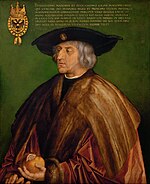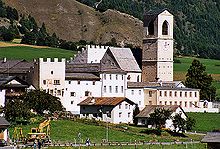Swabian War
| date | February 1499 to September 22, 1499 |
|---|---|
| place | |
| output | Victory of the Confederation |
| Peace treaty | Peace at Basel |
| Parties to the conflict | |
|---|---|
|
Old Confederation : Zurich Berne Lucerne Uri Schwyz Unterwalden Glarus train Solothurn Freiburg
and Abbey of St. Gallen St. Gallen Appenzell Biel Schaffhausen Zehngerichtebund Gotteshausbund Grauer Bund |
|
| Troop strength | |
| approx. 40,500 | approx. 24,000 |
| losses | |
|
approx. 13,000 |
approx. 2,500 |
Triesen · Hard · Bruderholz · Hallau · Schwaderloh · Frastanz · Calven · Dornach
The Swabian War , also known as the Swiss War or the Engadine War in historiography , was a military conflict between January and September 1499 between the Swiss Confederation on the one hand and the House of Habsburg on the other hand, and its key ally, the Swabian Federation , for supremacy in the Habsburg - federal border area. Although the Confederates won the war militarily, they could not record any territorial growth.
Political history
The contrast between Habsburg and the Swiss Confederation
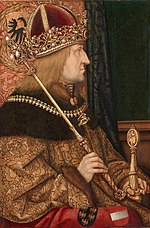
In the 15th century, the House of Habsburg lost all of its territories in the Swiss Central Plateau (1415 Aargau , 1460 Thurgau ) except for the Fricktal to the Swiss Confederation in several wars . After 1460, various federal towns began to form alliances with imperial cities north of the Rhine, such as Schaffhausen , Rottweil , Mülhausen , Buchhorn and Wangen . Zurich and Bern also tried to draw the city of Constance into the Swiss Confederation, which held the High Court over the federal communal rule of Thurgau and was otherwise closely linked to the Swiss Confederation. The inclusion of another large city in the federal government was rejected by the rural cantons. In the Waldshut War of 1468, the Confederates then also defined the Sundgau as their zone of influence. Finally, their triumph in the Burgundian Wars clearly confirmed the regional hegemony of the Confederation. The Habsburg regent of Tyrol and Upper Austria , Duke Sigmund of Austria , also had to recognize the confederate ownership in the so-called Eternal Direction in 1474. Only the head of the House of Habsburg, Emperor Friedrich III , remained irreconcilably opposed to the Swiss Confederation . who ruled only over the Archduchy of Austria , Styria and Carinthia . Nonetheless, the Swiss Confederation was still at risk of Habsburg restitution attempts in Aargau and Thurgau.
The rise of the House of Habsburg and the Swabian Confederation
In the second half of the 15th century, the House of Habsburg saw its substance more threatened than ever before. While the Roman-German Emperor Friedrich III. Since 1477 was involved in a catastrophic war with King Matthias Corvinus of Hungary, the Bavarian dukes from the House of Wittelsbach in southern Germany gained in power and prestige. Friedrich III. finally lost all of his lands to the King of Hungary , had to wander around the empire almost completely penniless and be endured by monasteries. His nephew, Duke Sigmund of Austria , pledged the County of Tyrol to the Bavarian dukes and sold them in 1487, with the exception of Vorarlberg .
In this situation, Emperor Friedrich III stepped. a, put Sigmund under guardianship and expelled all Wittelsbach-minded nobles from his countries. Among them were some gentlemen who were in castle law with the Confederation, z. B. Count Georg von Sargans and Count Gaudenz von Matsch, who then raised the mood against Habsburg in the Swiss Confederation. To the Wittelsbachern counter, united in 1488 to Habsburg initiative, the South German imperial cities, which in the nobility of the St. George shield united South German nobility, the Count of Württemberg and the country Sigmund, Further Austria and Tyrol , in the Swabian League . The confederates turned down the invitation to join. The Swabian Federation was now the strongest power in southern Germany, alongside the Confederation and the Duchy of Bavaria.
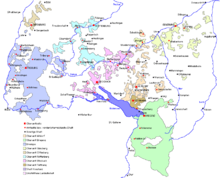
Emperor Friedrich III. had in the meantime had his son Maximilian elected German king in 1486 . He came into the possession of the Netherlands and the Duchy of Burgundy through his marriage to Mary of Burgundy , the daughter of Charles the Bold . In 1487, the Swiss Confederation was able to persuade Maximilian through negotiations to recognize the Eternal Direction in a so-called "Association" and also to guarantee all the privileges and legal possessions of the federal partners. This was the first time a Habsburg head of the empire had formally recognized the existence of the Confederation and its legal and territorial possessions. For its part, the Swiss Confederation committed itself to Maximilian "as the Roman king to do everything that, as subjects of the empire, they owe to the Roman king and the holy empire" . The turning of the Confederation towards the Reich was thwarted by France and Hungary, so that in 1488 all the federal estates except Zurich, Bern, Zug and Solothurn refused to sign the union with Maximilian. Ultimately, this association collapsed completely when in 1491 the Confederation, at the instigation of France, concluded a friendship and neutrality treaty with the dukes of Bavaria.
The competition between Swiss rice paddlers and Swabian mercenaries
The competition between France and Maximilian I for the Burgundian legacy led to a series of wars in Flanders and Burgundy , ultimately to the centuries-old French - Habsburg conflict . As a mercenary supplier to both parties, the Swiss Confederation was inevitably drawn into this conflict. In every federal town there was a French and a Habsburg party, which were in sometimes violent competition for the conclusion of lucrative pay contracts. While the central Swiss towns tended more towards France, Bern and Zurich tended to take the Habsburg party. Maximilian I tried in vain, as head of the empire, to prevent his federal subjects from traveling to France. Since the federal mercenary attracted in large numbers to France than to Maximilian, began this reinforced Swabian mercenaries to recruit. This created a competitive situation between the Swiss and Swabian mercenaries, which manifested itself in countless abuse, songs of derision and mutual accusations of treason.
The efforts of Emperor Frederick III to expand the Swabian League further and further provoked the Confederation, which viewed southern Swabia as its sphere of influence. The Swabian nobility, the imperial cities and even the common people were evidently gripped by an anti-federal mood. On the one hand, this was due to the fact that southern Germany often suffered from the war campaigns of the Confederates in the 15th century, and on the other hand, because the Confederates were the main competitors of the southern German cities in economic terms. There was also a great contrast between the republican-anti-aristocratic Swiss and the aristocratic world of southern Swabia. As a new factor, the competition between the Swiss rice hoppers and the Swabian mercenaries on the mercenary market came into play. The emergence of the strong Swabian Confederation in competition with the Swiss Confederation filled the cities, regions and the nobility of Swabia with satisfaction and pride and gave them new self-confidence. All these components led to the fact that the people north and south of the Rhine became increasingly foreign to each other, began to compose mocking verses and to refer to each other as "Kuhschweizer" or "Sauschwaben".
The imperial reform under King Maximilian I.
Between 1489 and 1491 Habsburg recovered spectacularly from earlier failures. Maximilian was finally able to inherit his Burgundian inheritance and in 1490 received Tyrol and Upper Austria . The sudden death of Matthias Corvinus relieved Habsburg in the east and gave Friedrich III. his lands back again. Friedrich III died in 1493, which enabled Maximilian to unite all Habsburg territories in one hand for the first time in a long time. As a result, the Swiss Confederation became the immediate neighbor of Habsburg on practically the entire northern border.
As the Roman-German king, Maximilian I worked to strengthen central power in the Holy Roman Empire . In 1495 he was able to push through an imperial reform at the Worms Reichstag . The imperial estates wrestled the king to agree to a Council of Regency from. In return, the Reichstag approved a general imperial tax, the common penny , to provide the king with means for waging war against France in Italy and against the Turks . In order to end the feuds , Maximilian also announced an Eternal Peace in Worms , which was to be monitored by the newly created Reich Chamber of Commerce. The Swiss Confederation was formally still part of the Reich, but did not recognize the Worms resolutions, which contradicted the old law, and, with the exception of Bern, had not been represented at the Reichstag.
Because of the St. Galler war of 1489/90, the Imperial Court still negotiating processes against St. Gallen and Appenzell , which ended with the fact that both in the imperial ban have been set. Since St. Gallen's linen trade with the Reich was made impossible, the Confederates intervened several times in vain at the Reichstag and Maximilian I, most recently in Innsbruck in 1497 . An agreement could not be reached because the confederates refused to recognize the court. Other similar processes ran against Mulhouse and Rottweil , on which, as exposed allies of the Confederates, pressure was now also exerted to submit to the imperial reform.
Outbreak of war
The confused legal situation in Graubünden provided the occasion for the war between Maximilian and the Swiss Confederation. Habsburg had acquired eight courts in the Prättigau by 1496 and had old rights in the Lower Engadine , in the Münstertal and in the Vinschgau , which were disputed by the bishops of Chur. In these areas of Habsburg influence, two unions had formed: the church federation of the subjects of the diocese of Chur and the ten-court federation of the former Toggenburg lords in Graubünden. The Habsburgs' claims urged the Church of God to form an alliance with the Confederation in 1498; Bishop Heinrich von Chur , at the same time imperial prince and member of the federation, got between the fronts.

In January 1499 the Habsburg governor of Tyrol had the Vinschgau and the Münstertal militarily occupied in order to assert his claim against the episcopal rights and the church federation. The real goal was probably to secure the Umbrail Pass , which enabled a direct connection between Innsbruck and Milan. This connection was decisive for safeguarding the military interests of the Habsburgs in Lombardy. While the Bishop of Chur was negotiating with Maximilian and reaching an armistice, the Association of Gods called on the Confederation for help, and the Governor of Tyrol called on the Swabian League. Both sides reached the lower Rhine valley near Sargans and Feldkirch with their troops at the beginning of February 1499. Although an agreement between the Tyrolean estates and Bishop Heinrich von Chur was sealed on January 26th in Glurns , which provided for a peaceful settlement of the dispute by the Reich Chamber of Commerce clashes between Swabian mercenaries and federal contingents at Balzers . Evidently provocations played a role on both sides. On February 6, the Uri captain Heini Wolleb briefly crossed the Rhine with a small contingent and set some houses on fire. This incident gave the Swabian troops a welcome pretext to occupy the St. Luzisteig Pass and Maienfeld on February 7th .
The accounts of this first phase of the war are contradicting and confusing. Apparently neither side wanted the conflict. After February 7, 1499, the Swabian Federation and the Swiss Confederation faced each other in a war that nobody had actually declared. Maximilian was certainly not interested in this conflict at this point, as he was involved in a protracted war with France in Burgundy and Italy.
Fighting
First collisions along the Rhine between Basel and Maienfeld
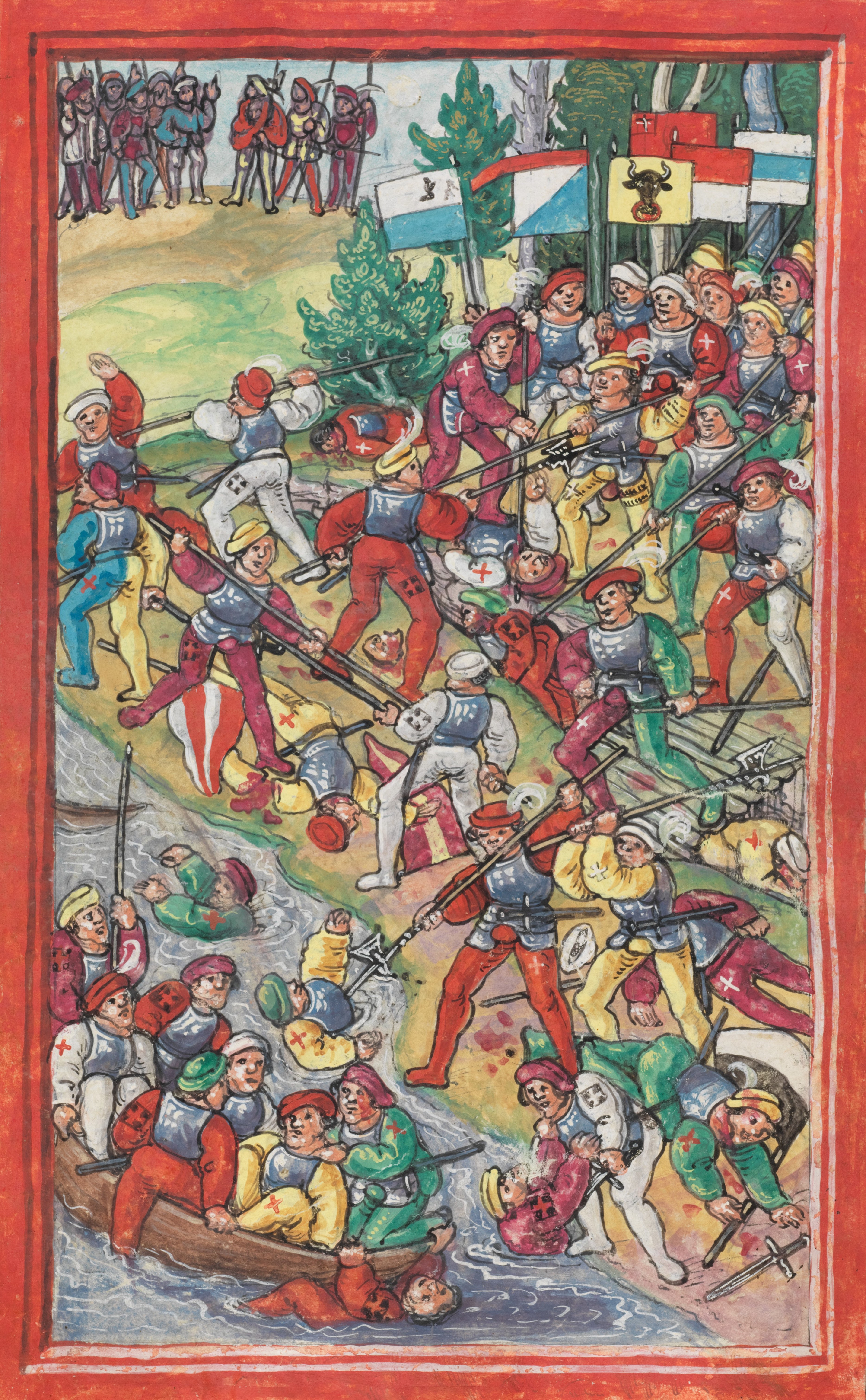
On February 11th and 12th, the Confederates and the Grisons expelled the Swabian federal troops from St. Luzisteig and Maienfeld and advanced into what is now the Principality of Liechtenstein . In the battle near Triesen a Swabian contingent was struck and the Confederates moved forward to Lake Constance. At Bregenz on February 22nd (note: the date of this battle is incorrectly stated on the overview map / info card of this article) they met another enemy army, which was destroyed in the battle near Hard . In the meantime, another federal army had invaded the Hegau and had devastated and plundered numerous villages and towns ( first Hegauerzug ). However, the Swiss soon withdrew across the border. Troops of the Swabian Confederation attacked Dornach in Solothurn only some time later, on March 22nd, but suffered a devastating defeat against a federal army in the battle on the Bruderholz .
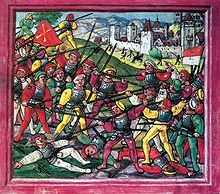
At the beginning of April Maximilian had the Reichstag of Mainz imposed the Reichsacht and the Reich War against the Confederation. Both sides then began to plunder and devastate enemy areas along the Rhine. The war was waged on both sides with extreme cruelty against the civilian population. The Federal Diet also decided on March 11th that no prisoners could be taken in the battle, i. This means that anyone who fell alive into the hands of the Confederates had to be cut down ("done away with"). The measure was aimed at the battle discipline of the fighting troops and was intended to prevent individual fighters from withdrawing uncontrollably from the battlefield after capturing an overwhelmed enemy and thus endangering the success of the battle. (In other conflicts such as the Burgundy Wars , the Confederates had done the usual business with ransom money for the prisoners.) So that this drastic decision would also be implemented by the troops, it was explicitly sworn by all troop contingents, which, apparently, like the sometimes very high ones The number of victims on the Swabian side shows that it had an impact.
The decision in the east: Triboltingen / Schwaderloh, Frastanz and Calven
On April 11, 1499, the Swabian Federation attempted a major attack on Thurgau. Some villages south of Konstanz were looted. When the federal troops encountered the Swabian army in the battle in Schwaderloh near Triboltingen , it was defeated. Around 1300 Swabians, including 150 citizens of Constance, died and the Confederates captured the entire artillery and the train. On April 17th, the Confederates moved again to Klettgau and Hegau and plundered several cities, such as Tiengen and Stühlingen (second Hegau parade). The whole war is actually characterized by such minor raids and looting, which were repeatedly interrupted by major battles. On April 20, such an expedition of the Confederates encountered fortifications of the Swabian Federation in Vorarlberg near Frastanz , which were supposed to prevent the enemy from entering the Montafon and Feldkirch . The battle at Frastanz was also victorious for the Confederates. It is seen as one of the decisive battles of the Swabian War.

In the meantime Maximilian had left the Netherlands for Constance. Since his call for an imperial war against the Swiss Confederation did not get the response he had hoped for, he was unable to bring together enough troops for an attack on the spot. He therefore decided to attack the Münstertal , which is far from the northern scene , as the Confederates were still bound in the Sundgau and on the Rhine. On May 21, the Confederates advanced into the Hegau for the third time with an army, but retreated across the Rhine without a battle in front of a strong army of the Swabian League. Before Maximilian was able to sufficiently strengthen his army, which was located near Glurns in Vinschgau, the Graubünden attacked with federal support and on May 22nd defeated the Habsburg forces in the battle of Calven . The overwhelmed opponents were pursued with cruel massacres - accompanied by looting and devastation - far down into the Vinschgau. Maximilian arrived a week later and devastated the Engadine with his troops in an act of revenge , but soon had to retreat from the approaching federal troops.

Since the Swabian Federation did not want to send forces to support Maximilian in Graubünden for fear of incursions by the confederates in its area, it had to return to the Lake Constance area. In July the Reichsheer finally arrived in Constance and was personally inspected by Maximilian on July 16. It comprised around 2500 horsemen and 10,000 foot servants. Numerous princes had traveled personally, such as Duke Georg von Baiern-Landshut, Albrecht of Saxony, Margrave Friedrich of Brandenburg-Ansbach, Count Ludwig of the Palatinate, Margrave Christoph of Baden and Duke Ulrich von Württemberg. The Confederates were now expecting another advance into Thurgau and they once again assembled a large army at Schwaderloh. Maximilian, however, remained inactive. The reason for this is unclear; it was probably due to the fact that, on the one hand, the Council of Princes could not agree on a plan and, on the other hand, the army of the Confederates seemed too strong. On July 22nd, Maximilian left the camp near Konstanz and drove with some troops to Lindau . On the way the troops landed at Rheineck , attacked Rorschach and plundered the town. When the king left Constance, most of the federal troops withdrew. On July 25th there was a final skirmish at Thayngen . The Swabian troops marched against Schaffhausen when they encountered surprisingly strong resistance when they sacked Thayngen. The attack was halted by around 30 local farmers entrenched in the fortified church tower for 17 hours, until their death by blowing up the tower, when an 800-strong federal relief force came dangerously closer from Schaffhausen. Thereupon the Swabian army of knights withdrew without a fight, although they outnumbered them.
The decision in the west: Dornach
The decision in the Swabian War finally fell in the west. In the meantime, the federal troops had dared to advance to the Hauenstein in Solothurn territory and defeated a federal contingent at Laufen an der Birs, but were unable to record any further successes apart from the recapture of the Birstal valley.
The long duration of the war without a decision put Maximilian under financial pressure from mid-July, as the Geldrian mercenaries in this western army threatened to withdraw because of outstanding wages. A report by the commandant, Count Heinrich von Fürstenberg , shows that he needed 6,000 guilders per month for the "Welsche Guard", some 1,000 horses, 4,000 guilders for the foot servants and 2,000 guilders for the lords and knights with their servants. The Swabian mercenaries also became restless, as the harvest was imminent and the end of the war still did not seem in sight. After a consultation with all the princes present in Ensisheim from July 4th to 10th, an attack on Solothurn was decided with the aim of conquering and looting all the area up to the Aare. So the army could at least be immobilized with booty.
The main attack took place near Basel. The main army of around 10,000 men moved under the command of Heinrich von Fürstenberg from the camp near Altkirch to the Solothurn fortress Dorneck , which was to be conquered in order to enable the passage over the Hauenstein. The confederates marched against him with a hastily drawn together 6000 men, especially the Solothurnians under Niklaus Konrad , and surprised the Swabian troops during the siege. In the battle of Dornach the Confederates won the decisive victory when around 1200 people from Lucerne and Zug arrived and the decisive factor was a several-hour struggle. After heavy losses, the Swabian army turned to flee and again left the entire entourage and artillery behind. Heinrich von Fürstenberg and around 3,000 other knights and mercenaries remained dead on the battlefield. The confederates lost around 500 men.
Peace negotiations and the end of the war

After the battle of Dornach, the Swabian knighthood had lost confidence in Maximilian's military capabilities and refused to raise a new army. The Swabian Confederation had hitherto paid a drastically higher blood toll than the Confederates, southern Swabia had been repeatedly devastated and looted, and practically all of its artillery had been lost to the Confederates. At the end of July, the Confederates did not undertake any further campaigns because the harvest was due. However, they refused a first peace offer by Maximilian in August.
Eventually, the Swabian War was brought to an end by events beyond the Alps. While Maximilian was busy with the Confederation, the French King Louis XII. the Duchy of Milan was largely brought under his control. The Duke of Milan, Ludovico Sforza , wanted to win over both King Maximilian I and the Confederates against the French and therefore mediated between the parties: Without peace, it was neither possible to attract Swiss mercenaries nor Swabian mercenaries for a campaign against Louis XII. to advertise with went both at the same time.
Indeed: although French agents tried to prevent an agreement at the Federal Diet, the Milanese managed to mediate with plenty of bribes. On September 22nd, 1499, the peace in Basel between Maximilian and the Confederates was sealed. In the peace treaty there was no longer any talk of an imperial war , but only of a war between two imperial estates: Maximilian therefore only appeared in his capacity as Archduke of Austria and Count of Tyrol, while Bishop Heinrich von Chur stood on the other side.
The Peace of Basel confirmed the Habsburg rights in the eight courts of the Prättigau, awarded the highest jurisdiction in Thurgau to the Confederates and established an arbitration system for disputes between Habsburg and the Confederates. The relationship between the Confederates and the Reich was not mentioned. It was only stipulated that the German king had to set aside all respect and lawsuits and complaints that had been imposed or initiated before and during the war "and that otherwise in relation to all other matters not included in this, both parties should remain how they existed before the war and how they came from », ie the legal status quo ante should be restored. This paralyzed the Reich Chamber of Commerce against the Swiss Confederation and actually recognized the factual independent status of the Swiss Confederation before the conflict. The resolutions of the imperial reform were therefore never implemented in the Confederation. The imperial cities of Basel and Schaffhausen , however, joined the Swiss Confederation in 1501 .
Conclusion

In the middle of the imperial eagle , surrounded by the coats of arms of the federal places and the most important allies. The use of the imperial eagle shows that there could be no question of a complete separation of the Confederation from the empire.
Due to the Swabian War, the Confederation was able to successfully defend its independence within the Holy Roman Empire. From a legal point of view, however, it remained part of the empire until the Peace of Westphalia in 1648. The imperial eagle was therefore continued to be used in Switzerland when the coats of arms of the individual regions, imperial cities or all federal places as a whole were depicted, as they were understood to be the empire-immediate estates. After all, kingship was the source of all privileges, rights and the actual statehood of all members of the Confederation. In the 19th century, however, the result of the Swabian War was interpreted to mean that the Peace of Basel had achieved “de facto independence” from the Reich.
In terms of territory, the peace had one significant consequence: the district jurisdiction over the Thurgau went from the city of Constance to the Swiss Confederation, thereby reaching the Rhine and Lake Constance as the northern border and closure of the territory of the Swiss Confederation. Konstanz itself definitely remained outside the Confederation.
Thanks to the victory over Habsburg and the threat they experienced together, the Swiss Confederation and its allies moved closer together internally. In the Swabian War, the term “Swiss” as a collective name for all confederates and relatives finally established itself in the Confederation itself. The Confederates have been called "Swiss" by German chroniclers since the 14th century. The name of the canton Schwyz has been carried over to all other confederates. For many confederates, especially from the cities, this initially appeared to be an insult, as they did not want to be lumped together with the farmers from Schwyz. In southern Germany and the Habsburg lands, “Swiss” was often used with the addition “Kuh-Schweizer” to indicate the peasant, non-aristocratic origins of the Confederates. In addition, the term also contained an allusion to alleged sodomist practices of the farmers with their cows. Paradoxically, the dirty name was spread throughout Europe as a result of the Burgundian and Swabian Wars and also became popular in the Swiss Confederation itself. The insulted wore the name of abuse, strengthened by their successes, with pride (see Melioration ). However, the state name "Switzerland" never established itself as the official name. The combination “Swiss Confederation” had been the most widespread since the 17th century and in 1803 it became the official name of the newly formed state under Napoleon's supervision.
With the peace of Basel and the admission of Basel and Schaffhausen into the Confederation, the north and east borders of the Confederation were fixed by 1798, apart from a few minor corrections. Conversely, the recognition of the confederate property by King Maximilian I also meant that the Confederation renounced further expansion to the north by concluding further castle rights and alliances with landscapes and cities, as had been the practice up to now. The Swabian War was the last major conflict between the Confederation and Habsburg until the Napoleonic era.
Despite several successful campaigns of conquest and looting by federal contingents in the Sundgau , Klettgau and the Hegau, no major territorial gains could be realized through the Swabian War. Solothurn, Schaffhausen and Zurich tried several times to persuade the other confederates to occupy and secure the conquests for a longer period of time, but the mistrust between the rural and urban cantons prevented any long-term acquisition of territory. The cruelty of the war also alienated the population of the border areas of the Confederation, so that the support of an annexation by the local population was no longer to be expected.
literature
- Elisabeth von Gleichenstein et al .: Swabian War - Swiss War 1499 . Constance and Thurgau - separated for 500 years . Ed .: Officer Society of the Canton of Thurgau . Rosgartenmuseum Konstanz, Kreuzlingen, Bodan 1999 (without ISBN).
- Andre Gutmann: The Swabian War Chronicle of Kaspar Frey and its position in the federal historiography of the 16th century . In: Publications of the Commission for Historical Regional Studies in Baden-Württemberg . Row B: Research . tape 176 , 2010, ISBN 978-3-17-020982-4 , pp. 21-38 .
- Ernst Hunkeler: The Swabian War in our lands , Peter Meilli publishing house, Schaffhausen 1973 ISBN 3-85805-015-6
- Peter Niederhäuser, Werner Fischer, Florian Hitz et al .: From the «War of Freedom» to the myth of history . 500 years of the Swiss or Swabian War . Ed .: Adult Education Center of the Canton of Zurich. Chronos, Zurich 2000, ISBN 978-3-905313-50-5 .
- Willibald Pirckheimer : The Swiss War . Ed .: Wolfgang Schiel. Military publishing house of the German Democratic Republic, Berlin 1988, ISBN 978-3-327-00633-7 (with a historical-biographical study).
- Willibald Pirckheimer: The Swiss War / De bello Suitense sive Eluetico . In Latin and German. Newly translated and commented by Fritz Wille . Merker im Effingerhof, Baden 1998, ISBN 3-85648-094-3 .
- Heinrich Witte (editor): Excerpts from documents on the history of the Swabian War. In: Journal for the History of the Upper Rhine, NF Volume 14 (1899), m66 – m144 in the Internet Archive
- Heinrich Witte (editor): Excerpts from documents on the history of the Swabian War (continuation). In: Journal for the History of the Upper Rhine, NF Volume 15 (1900), m3 – m100 in the Internet Archive
- Hans Frey: About Basel's neutrality during the Swabian War. In: Contributions to patriotic history, Volume 10 (1875), pp. 318–349 doi: 10.5169 / seals-110714
Web links
- Andre Gutmann: Swabian War. In: Historical Lexicon of Switzerland .
- Alois Niederstätter: Swabian War / Swiss War , 1499 at www.historisches-lexikon-bayerns.de
- Forum 1499 - The Swabian War, exhibition project 1999
- Source documentation on the Swabian War with further references and secondary literature in full text
- City Archives Schaffhausen - The Swabian War of 1499 from the perspective of the city of Schaffhausen
- Homepage of the Thurgau Landsknechte, who keep the memory of the Battle of Schwaderloh alive
- General of the Swabian War - Count Heinrich von Fürstenberg
- “Swabian War” themed portal on historicum.net

